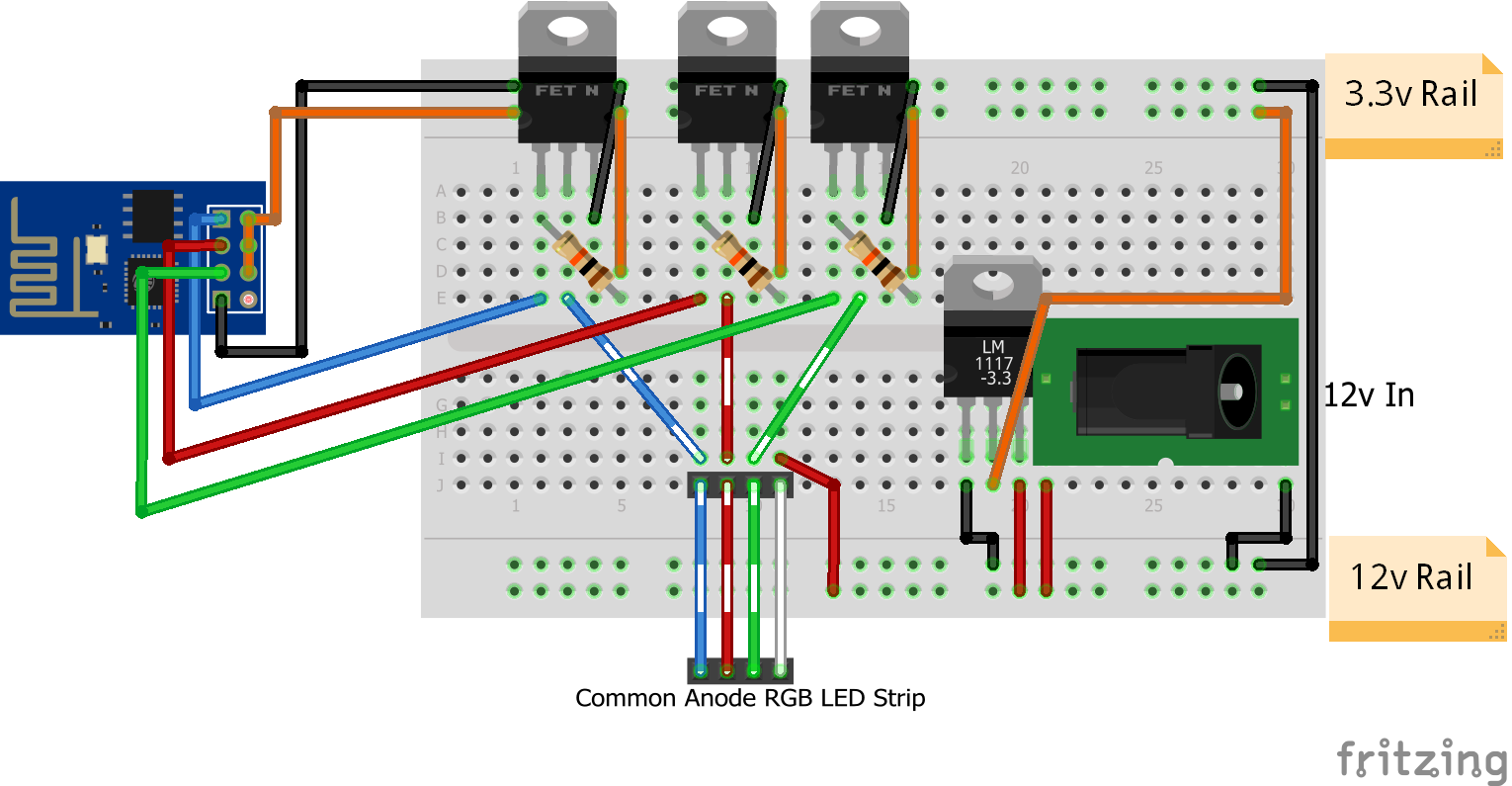This project served a need originally, but I no longer use or maintain it. I use and highly recommend ESPHome, which supports everything this project can handle and much, much more. ESPHome has a local API with a native integration with Home Assistant, but can also be used separately from Home Assistant using the MQTT component.
As an example, this is an initial configuration you could use in ESPHome to replace this whole project for an RGB light using MQTT:
esphome:
name: rgb-light # Update this.
esp8266:
# Update to match your board. See: https://esphome.io/components/esp8266.html
board: d1_mini
wifi:
ssid: wifi_ssid # Update this (ideally using !secrets)
password: wifi_password # Update this (ideally using !secrets)
mqtt:
broker: 192.168.1.2 # Update this.
username: username # Update this (ideally using !secrets)
password: password # Update this (ideally using !secrets)
logger:
ota:
output:
- platform: esp8266_pwm
id: red_pin
pin: GPIO0 # Update this.
- platform: esp8266_pwm
id: green_pin
pin: GPIO2 # Update this.
- platform: esp8266_pwm
id: blue_pin
pin: GPIO3 # Update this.
light:
- platform: rgb
name: "RGB Light"
red: red_pin
green: green_pin
blue: blue_pinSee the relevant light components for more help:
Thank you for using this repo and providing feedback. Going forward, I've moved some of my development attention to supporting ESPHome.
Previous README below.
This project adds an easy way to create DIY lighting for Home Assistant, an amazing, extensible, open-source home automation system.
I was frustrated that the built-in MQTT light didn't support transitions (fading between colors/brightnesses), and that it uses multiple separate calls to set the different values (state (on/off), brightness, color), so I decided to make my own version. As of version 0.26, the MQTT JSON light platform has been merged into Home Assistant.
By sending a JSON payload (in an MQTT message), Home Assistant can include whichever fields are necessary, reducing the round trips from 3 to 1. For example, this is a sample payload including most of the fields:
{
"state": "ON",
"brightness": 120,
"color": {
"r": 255,
"g": 100,
"b": 100
},
"transition": 5
}To set this system up, you need to configure the MQTT light component in Home Assistant and set up a light to control. This guide assumes that you already have Home Assistant set up and running. If not, see the installation guides here.
-
In your
configuration.yaml, add the following, depending on the supported features of the light:# Only one color: light: - platform: mqtt schema: json name: mqtt_json_light_1 state_topic: "home/json_brightness" command_topic: "home/json_brightness/set" brightness: true effect: true effect_list: [flash] optimistic: false qos: 0 # RGB: light: - platform: mqtt schema: json name: mqtt_json_light_2 state_topic: "home/rgb1" command_topic: "home/rgb1/set" brightness: true rgb: true effect: true effect_list: [colorfade_slow, colorfade_fast, flash] optimistic: false qos: 0 # RGBW: light: - platform: mqtt schema: json name: mqtt_json_light_3 state_topic: "home/rgbw1" command_topic: "home/rgbw1/set" brightness: true rgb: true white_value: true effect: true effect_list: [colorfade_slow, colorfade_fast, flash] optimistic: false qos: 0
-
Set the
name,state_topic, andcommand_topicto values that make sense for you. -
Restart Home Assistant. Depending on how you installed it, the process differs. For a Raspberry Pi All-in-One install, use
sudo systemctl restart home-assistant.service(or just restart the Pi).
I'm using ESP8266-01 microcontrollers for my lights because they are so cheap and small. The downside of the size and price is that programming them can be a bit of a hassle. There are many sites that go into detail, so I won't do it here. You'll need an ESP set up to work with the Arduino IDE. See the readme here for instructions. Another good device to work with is the Wemos D1 Mini, which has a built-in micro-USB port and is much easier to program.
- Using the Library Manager in the Arduino IDE, install ArduinoJSON and PubSubClient. You can find the Library Manager in the "Sketch" menu under "Include Library" -> "Manage Libraries..."
- NOTE:: At the moment, this project only supports ArduinoJSON version 5. The default is now version 6, so you'll have to specify the version to install in the dropdown in the Library Manager window.
- Open the
mqtt_esp8266_lightproject in the Arduino IDE. - Update the
config-sample.hfile with your settings for LED type, pin numbers, WiFi settings, and MQTT settings. - Review the comments to help with the options. For the
CONFIG_STRIPoption, choose one ofBRIGHTNESS,RGB, orRGBW. - Ensure that the
CONFIG_MQTT_CLIENT_IDsetting is a unique value for your network. - Set
CONFIG_MQTT_TOPIC_STATEandCONFIG_MQTT_TOPIC_SETto match the values you put in yourconfiguration.yaml. - Save the configuration file as
config.h. - Open the
.inofile in the Arduino IDE and upload to an ESP with the correct connections.
Originally, there were separate Arduino sketches for each of the supported light types. This quickly became redundant and hard-to-maintain, so the new, unified sketch was created.
Please use this (mqtt_esp8266_light) sketch going forward. The deprecated sketches will not receive new features and will be removed from the project in the future.
For an RGB LED strip using N-MOSFETs for control, you'll want to wire it similar to this:

Note that the MOSFETs have pull-up resistors in this setup. This means that the lights may flash on when the module resets, but it was necessary to keep the ESP's pins in the right start state.